Executive Summary: International Trade, Finance, and Investment
VerifiedAdded on 2022/12/30
|16
|4138
|2
Report
AI Summary
This report provides a comprehensive overview of international trade, finance, and investment. It begins by outlining the structure of the international financial system, detailing how financial organizations and markets, including stock, share, bond, and derivatives markets, operate. The report then explores capital allocation within both the domestic and international economies, discussing relevant theories and models such as comparative advantage, aggregate competition, classical economics, monetarism, and new classical economics. An evaluation of the Indian economy is presented, analyzing its growth, reforms, and the challenges it faces due to industrialization and trade policies. The report also examines key financial instruments, exchange rate mechanisms, and the role of government intervention. Finally, it offers recommendations based on the analysis.
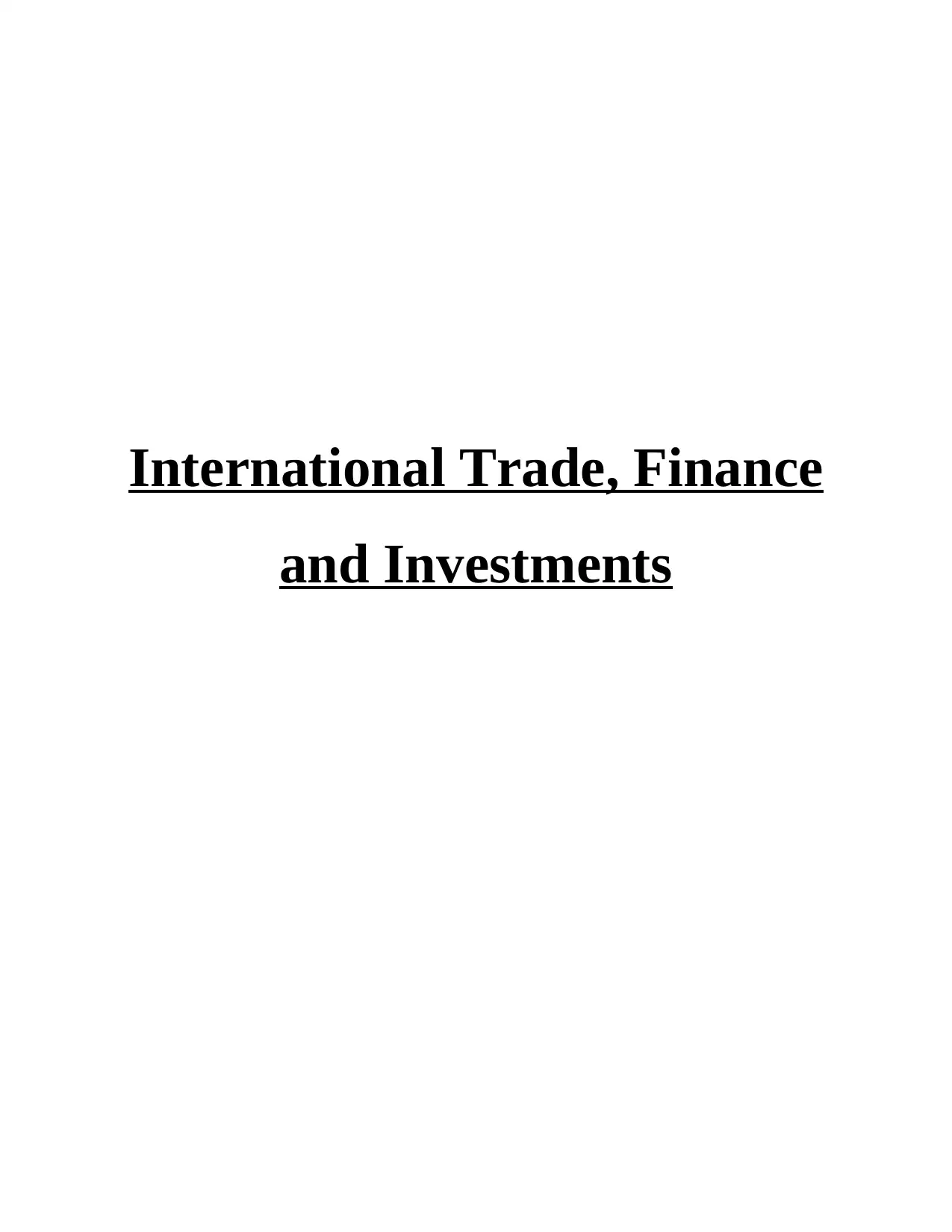
International Trade, Finance
and Investments
and Investments
Paraphrase This Document
Need a fresh take? Get an instant paraphrase of this document with our AI Paraphraser
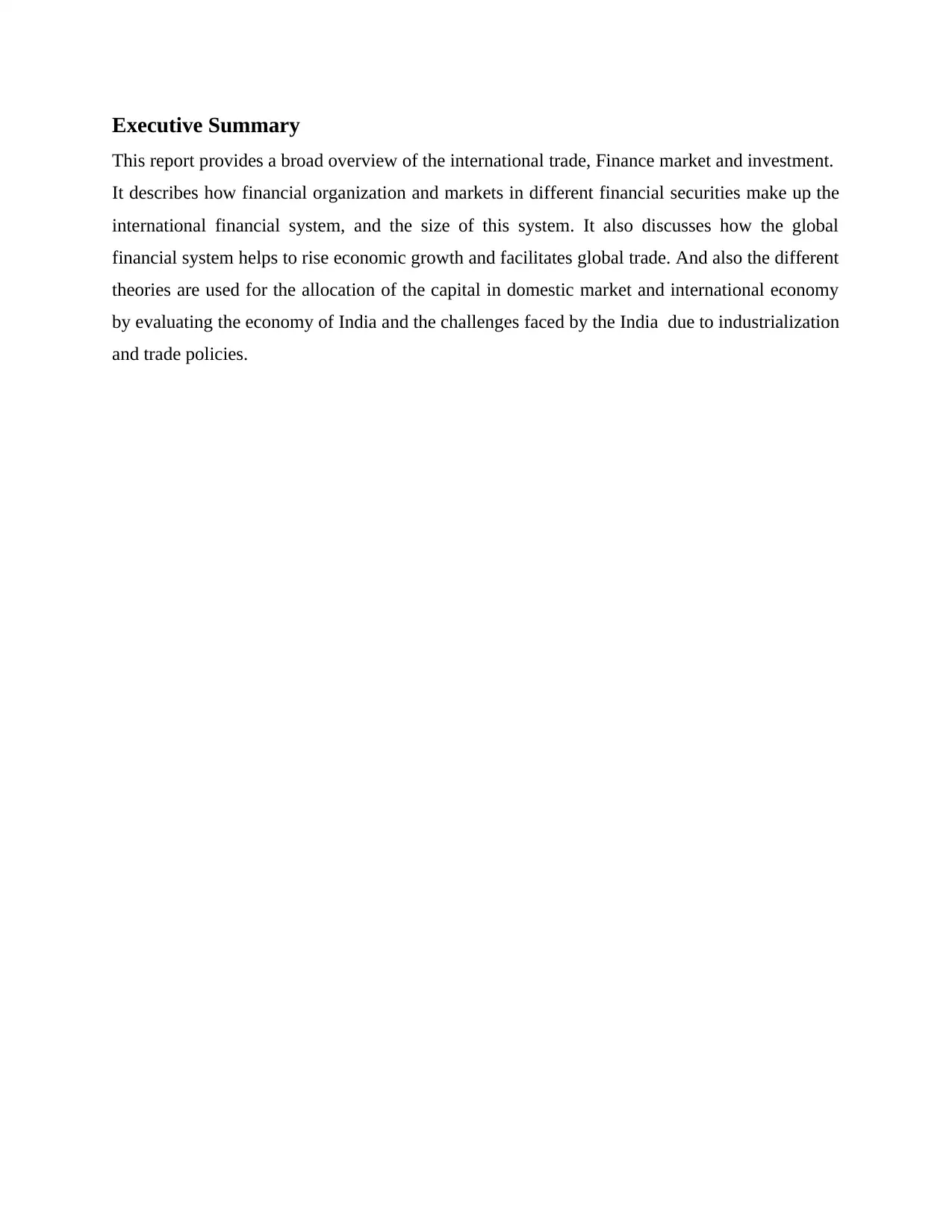
Executive Summary
This report provides a broad overview of the international trade, Finance market and investment.
It describes how financial organization and markets in different financial securities make up the
international financial system, and the size of this system. It also discusses how the global
financial system helps to rise economic growth and facilitates global trade. And also the different
theories are used for the allocation of the capital in domestic market and international economy
by evaluating the economy of India and the challenges faced by the India due to industrialization
and trade policies.
This report provides a broad overview of the international trade, Finance market and investment.
It describes how financial organization and markets in different financial securities make up the
international financial system, and the size of this system. It also discusses how the global
financial system helps to rise economic growth and facilitates global trade. And also the different
theories are used for the allocation of the capital in domestic market and international economy
by evaluating the economy of India and the challenges faced by the India due to industrialization
and trade policies.
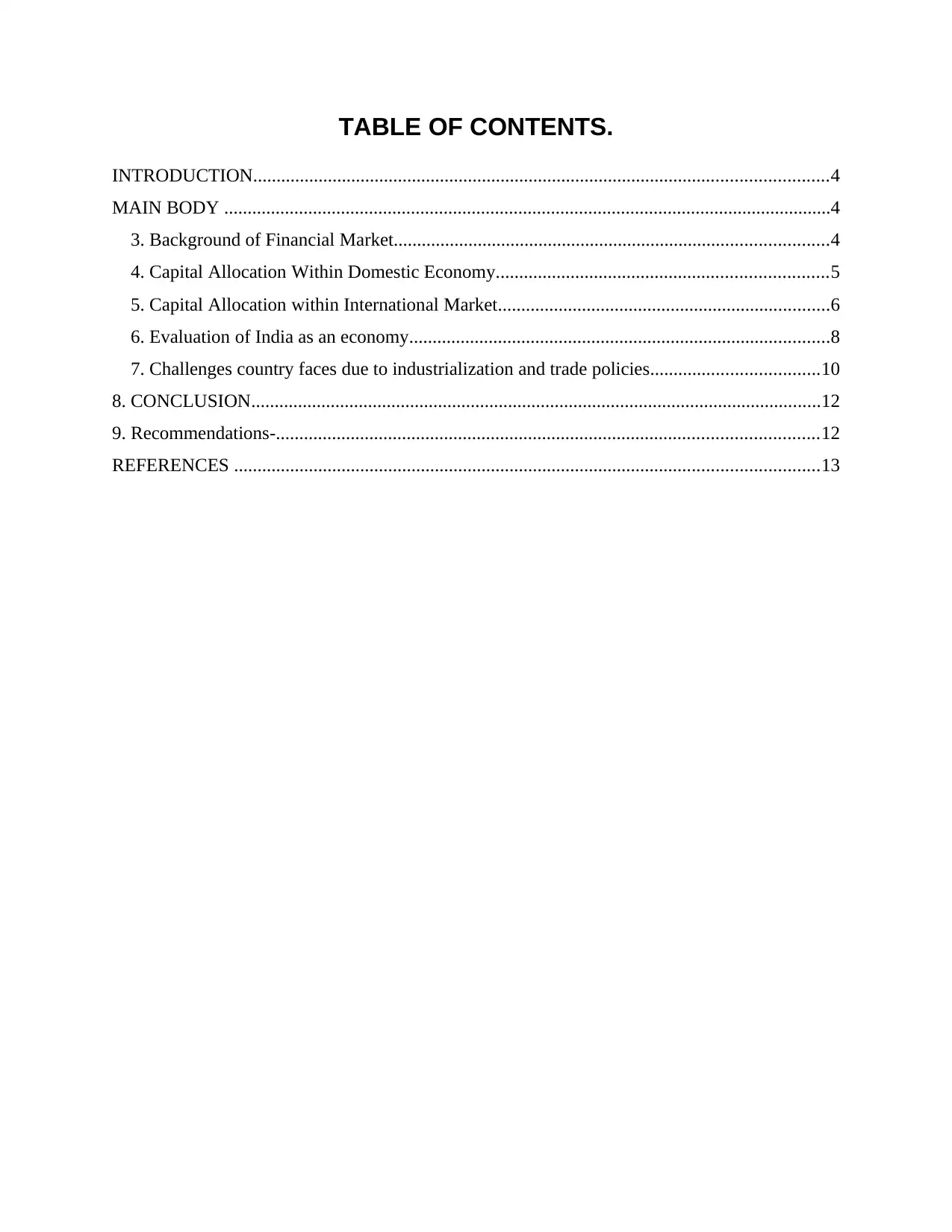
TABLE OF CONTENTS.
INTRODUCTION...........................................................................................................................4
MAIN BODY ..................................................................................................................................4
3. Background of Financial Market.............................................................................................4
4. Capital Allocation Within Domestic Economy.......................................................................5
5. Capital Allocation within International Market.......................................................................6
6. Evaluation of India as an economy..........................................................................................8
7. Challenges country faces due to industrialization and trade policies....................................10
8. CONCLUSION..........................................................................................................................12
9. Recommendations-....................................................................................................................12
REFERENCES .............................................................................................................................13
INTRODUCTION...........................................................................................................................4
MAIN BODY ..................................................................................................................................4
3. Background of Financial Market.............................................................................................4
4. Capital Allocation Within Domestic Economy.......................................................................5
5. Capital Allocation within International Market.......................................................................6
6. Evaluation of India as an economy..........................................................................................8
7. Challenges country faces due to industrialization and trade policies....................................10
8. CONCLUSION..........................................................................................................................12
9. Recommendations-....................................................................................................................12
REFERENCES .............................................................................................................................13
⊘ This is a preview!⊘
Do you want full access?
Subscribe today to unlock all pages.

Trusted by 1+ million students worldwide
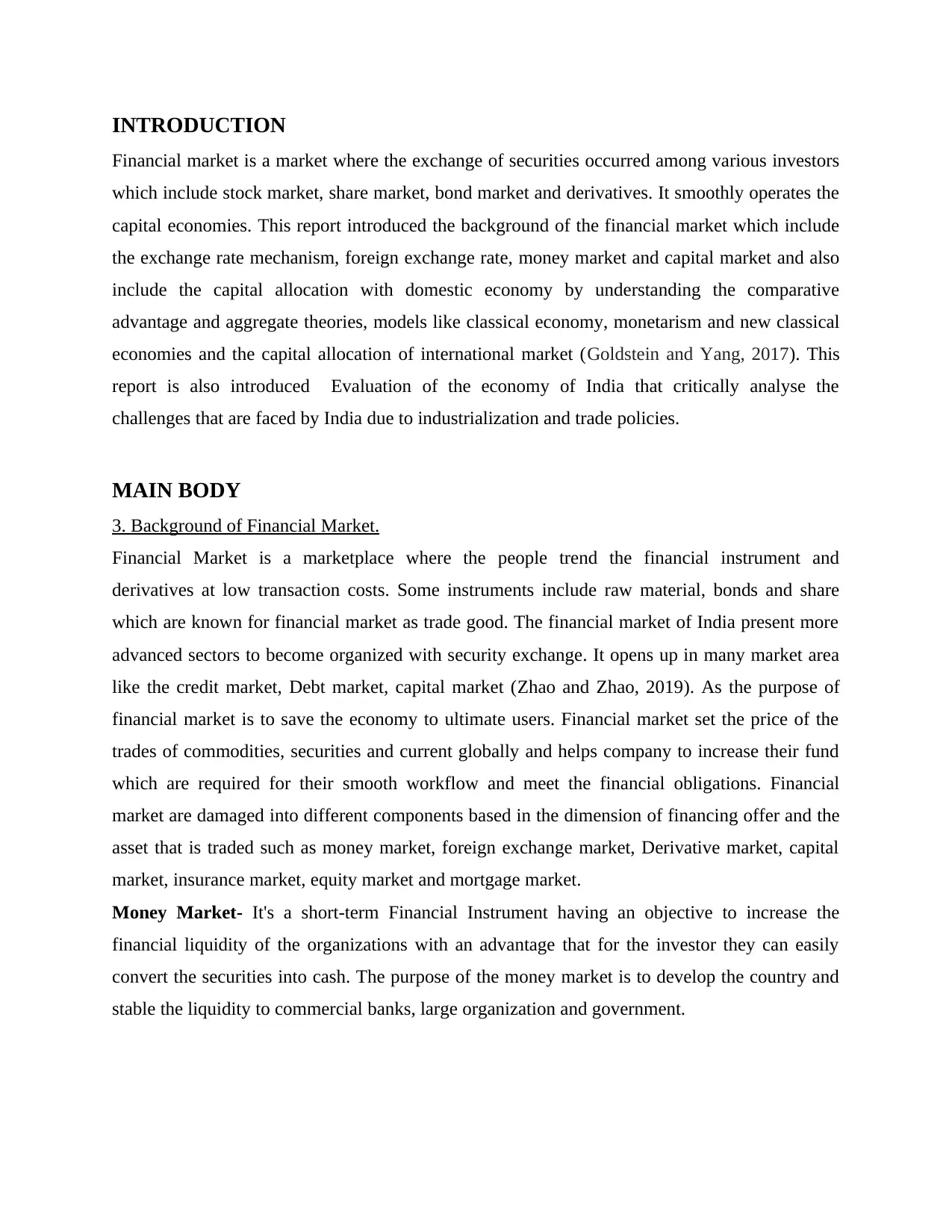
INTRODUCTION
Financial market is a market where the exchange of securities occurred among various investors
which include stock market, share market, bond market and derivatives. It smoothly operates the
capital economies. This report introduced the background of the financial market which include
the exchange rate mechanism, foreign exchange rate, money market and capital market and also
include the capital allocation with domestic economy by understanding the comparative
advantage and aggregate theories, models like classical economy, monetarism and new classical
economies and the capital allocation of international market (Goldstein and Yang, 2017). This
report is also introduced Evaluation of the economy of India that critically analyse the
challenges that are faced by India due to industrialization and trade policies.
MAIN BODY
3. Background of Financial Market.
Financial Market is a marketplace where the people trend the financial instrument and
derivatives at low transaction costs. Some instruments include raw material, bonds and share
which are known for financial market as trade good. The financial market of India present more
advanced sectors to become organized with security exchange. It opens up in many market area
like the credit market, Debt market, capital market (Zhao and Zhao, 2019). As the purpose of
financial market is to save the economy to ultimate users. Financial market set the price of the
trades of commodities, securities and current globally and helps company to increase their fund
which are required for their smooth workflow and meet the financial obligations. Financial
market are damaged into different components based in the dimension of financing offer and the
asset that is traded such as money market, foreign exchange market, Derivative market, capital
market, insurance market, equity market and mortgage market.
Money Market- It's a short-term Financial Instrument having an objective to increase the
financial liquidity of the organizations with an advantage that for the investor they can easily
convert the securities into cash. The purpose of the money market is to develop the country and
stable the liquidity to commercial banks, large organization and government.
Financial market is a market where the exchange of securities occurred among various investors
which include stock market, share market, bond market and derivatives. It smoothly operates the
capital economies. This report introduced the background of the financial market which include
the exchange rate mechanism, foreign exchange rate, money market and capital market and also
include the capital allocation with domestic economy by understanding the comparative
advantage and aggregate theories, models like classical economy, monetarism and new classical
economies and the capital allocation of international market (Goldstein and Yang, 2017). This
report is also introduced Evaluation of the economy of India that critically analyse the
challenges that are faced by India due to industrialization and trade policies.
MAIN BODY
3. Background of Financial Market.
Financial Market is a marketplace where the people trend the financial instrument and
derivatives at low transaction costs. Some instruments include raw material, bonds and share
which are known for financial market as trade good. The financial market of India present more
advanced sectors to become organized with security exchange. It opens up in many market area
like the credit market, Debt market, capital market (Zhao and Zhao, 2019). As the purpose of
financial market is to save the economy to ultimate users. Financial market set the price of the
trades of commodities, securities and current globally and helps company to increase their fund
which are required for their smooth workflow and meet the financial obligations. Financial
market are damaged into different components based in the dimension of financing offer and the
asset that is traded such as money market, foreign exchange market, Derivative market, capital
market, insurance market, equity market and mortgage market.
Money Market- It's a short-term Financial Instrument having an objective to increase the
financial liquidity of the organizations with an advantage that for the investor they can easily
convert the securities into cash. The purpose of the money market is to develop the country and
stable the liquidity to commercial banks, large organization and government.
Paraphrase This Document
Need a fresh take? Get an instant paraphrase of this document with our AI Paraphraser
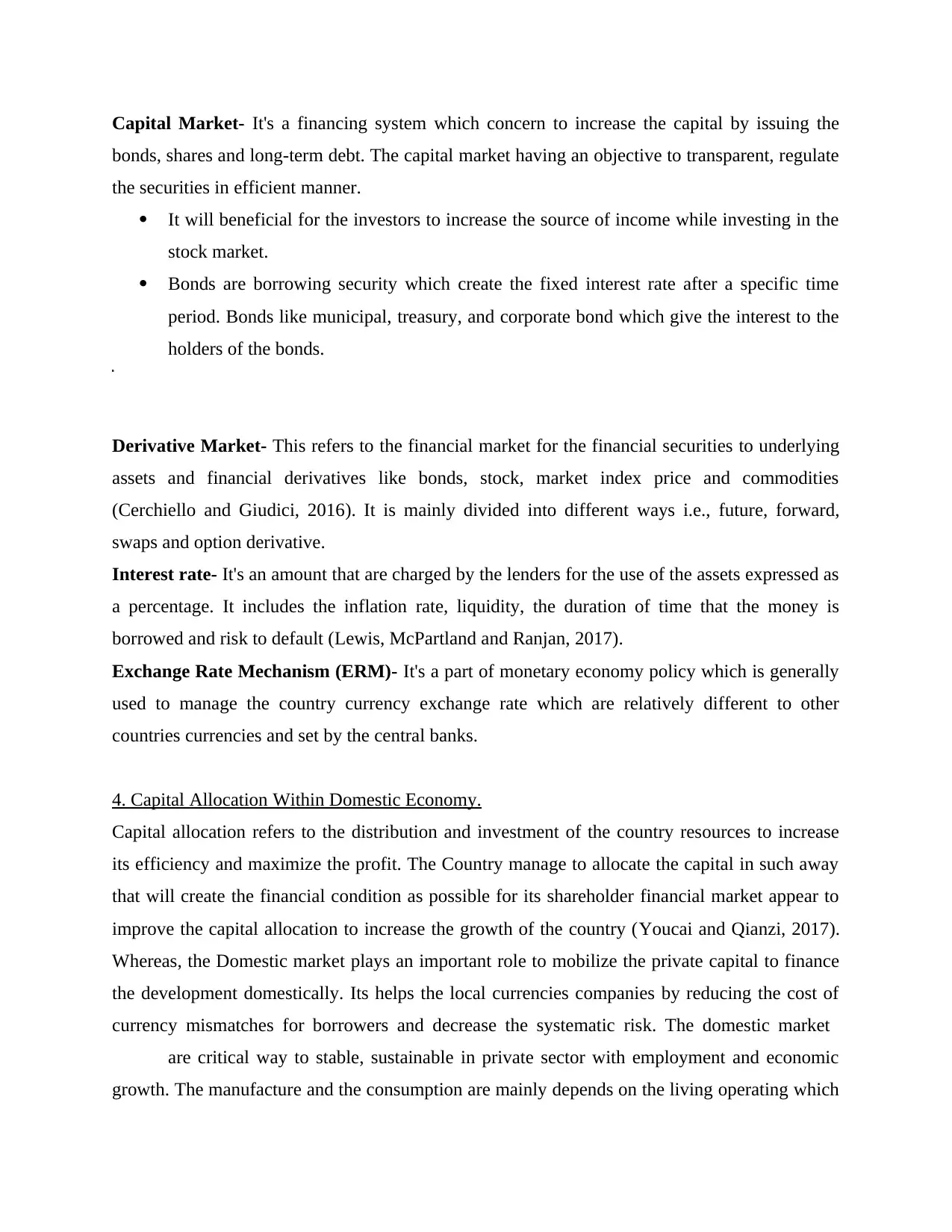
Capital Market- It's a financing system which concern to increase the capital by issuing the
bonds, shares and long-term debt. The capital market having an objective to transparent, regulate
the securities in efficient manner.
It will beneficial for the investors to increase the source of income while investing in the
stock market.
Bonds are borrowing security which create the fixed interest rate after a specific time
period. Bonds like municipal, treasury, and corporate bond which give the interest to the
holders of the bonds.
Derivative Market- This refers to the financial market for the financial securities to underlying
assets and financial derivatives like bonds, stock, market index price and commodities
(Cerchiello and Giudici, 2016). It is mainly divided into different ways i.e., future, forward,
swaps and option derivative.
Interest rate- It's an amount that are charged by the lenders for the use of the assets expressed as
a percentage. It includes the inflation rate, liquidity, the duration of time that the money is
borrowed and risk to default (Lewis, McPartland and Ranjan, 2017).
Exchange Rate Mechanism (ERM)- It's a part of monetary economy policy which is generally
used to manage the country currency exchange rate which are relatively different to other
countries currencies and set by the central banks.
4. Capital Allocation Within Domestic Economy.
Capital allocation refers to the distribution and investment of the country resources to increase
its efficiency and maximize the profit. The Country manage to allocate the capital in such away
that will create the financial condition as possible for its shareholder financial market appear to
improve the capital allocation to increase the growth of the country (Youcai and Qianzi, 2017).
Whereas, the Domestic market plays an important role to mobilize the private capital to finance
the development domestically. Its helps the local currencies companies by reducing the cost of
currency mismatches for borrowers and decrease the systematic risk. The domestic market
are critical way to stable, sustainable in private sector with employment and economic
growth. The manufacture and the consumption are mainly depends on the living operating which
bonds, shares and long-term debt. The capital market having an objective to transparent, regulate
the securities in efficient manner.
It will beneficial for the investors to increase the source of income while investing in the
stock market.
Bonds are borrowing security which create the fixed interest rate after a specific time
period. Bonds like municipal, treasury, and corporate bond which give the interest to the
holders of the bonds.
Derivative Market- This refers to the financial market for the financial securities to underlying
assets and financial derivatives like bonds, stock, market index price and commodities
(Cerchiello and Giudici, 2016). It is mainly divided into different ways i.e., future, forward,
swaps and option derivative.
Interest rate- It's an amount that are charged by the lenders for the use of the assets expressed as
a percentage. It includes the inflation rate, liquidity, the duration of time that the money is
borrowed and risk to default (Lewis, McPartland and Ranjan, 2017).
Exchange Rate Mechanism (ERM)- It's a part of monetary economy policy which is generally
used to manage the country currency exchange rate which are relatively different to other
countries currencies and set by the central banks.
4. Capital Allocation Within Domestic Economy.
Capital allocation refers to the distribution and investment of the country resources to increase
its efficiency and maximize the profit. The Country manage to allocate the capital in such away
that will create the financial condition as possible for its shareholder financial market appear to
improve the capital allocation to increase the growth of the country (Youcai and Qianzi, 2017).
Whereas, the Domestic market plays an important role to mobilize the private capital to finance
the development domestically. Its helps the local currencies companies by reducing the cost of
currency mismatches for borrowers and decrease the systematic risk. The domestic market
are critical way to stable, sustainable in private sector with employment and economic
growth. The manufacture and the consumption are mainly depends on the living operating which
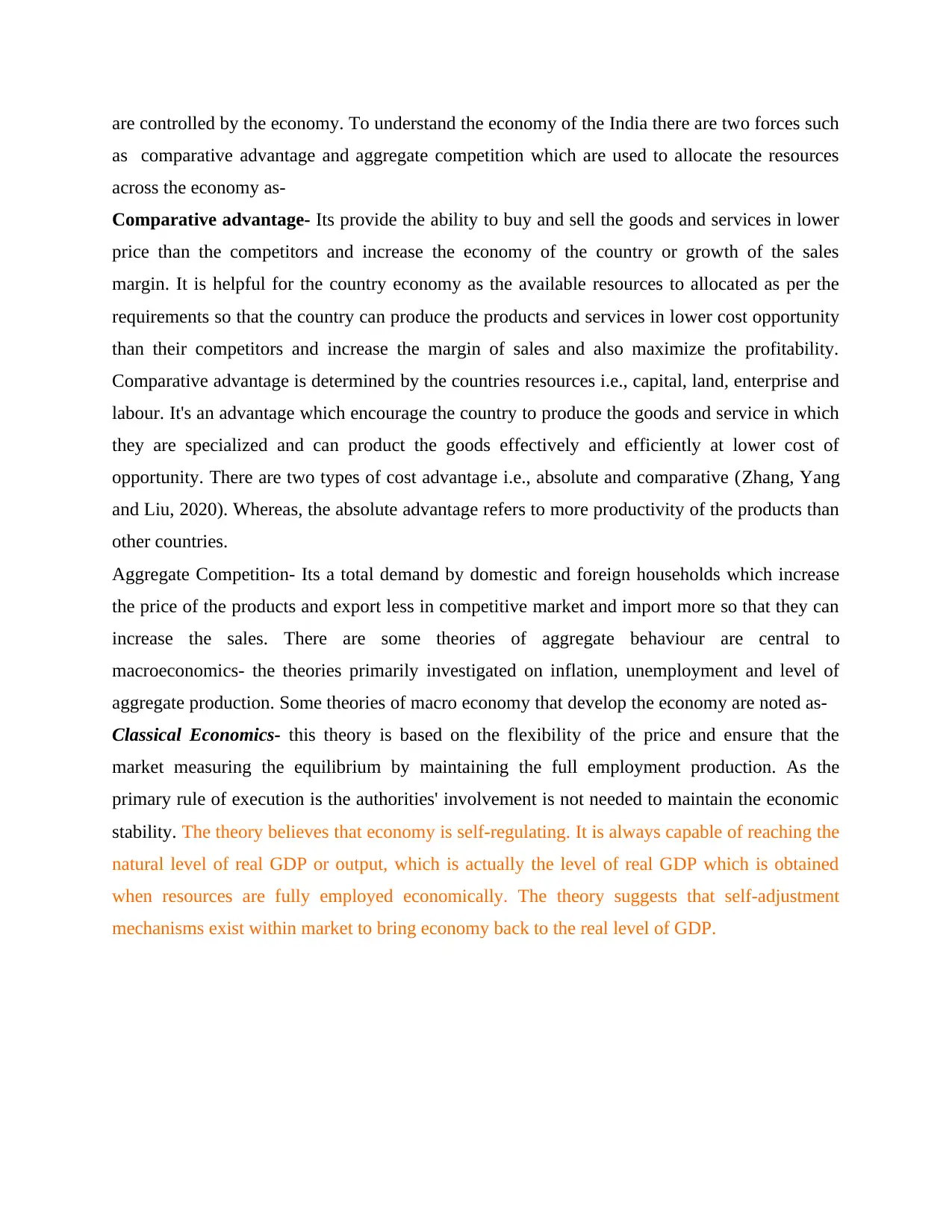
are controlled by the economy. To understand the economy of the India there are two forces such
as comparative advantage and aggregate competition which are used to allocate the resources
across the economy as-
Comparative advantage- Its provide the ability to buy and sell the goods and services in lower
price than the competitors and increase the economy of the country or growth of the sales
margin. It is helpful for the country economy as the available resources to allocated as per the
requirements so that the country can produce the products and services in lower cost opportunity
than their competitors and increase the margin of sales and also maximize the profitability.
Comparative advantage is determined by the countries resources i.e., capital, land, enterprise and
labour. It's an advantage which encourage the country to produce the goods and service in which
they are specialized and can product the goods effectively and efficiently at lower cost of
opportunity. There are two types of cost advantage i.e., absolute and comparative (Zhang, Yang
and Liu, 2020). Whereas, the absolute advantage refers to more productivity of the products than
other countries.
Aggregate Competition- Its a total demand by domestic and foreign households which increase
the price of the products and export less in competitive market and import more so that they can
increase the sales. There are some theories of aggregate behaviour are central to
macroeconomics- the theories primarily investigated on inflation, unemployment and level of
aggregate production. Some theories of macro economy that develop the economy are noted as-
Classical Economics- this theory is based on the flexibility of the price and ensure that the
market measuring the equilibrium by maintaining the full employment production. As the
primary rule of execution is the authorities' involvement is not needed to maintain the economic
stability. The theory believes that economy is self-regulating. It is always capable of reaching the
natural level of real GDP or output, which is actually the level of real GDP which is obtained
when resources are fully employed economically. The theory suggests that self-adjustment
mechanisms exist within market to bring economy back to the real level of GDP.
as comparative advantage and aggregate competition which are used to allocate the resources
across the economy as-
Comparative advantage- Its provide the ability to buy and sell the goods and services in lower
price than the competitors and increase the economy of the country or growth of the sales
margin. It is helpful for the country economy as the available resources to allocated as per the
requirements so that the country can produce the products and services in lower cost opportunity
than their competitors and increase the margin of sales and also maximize the profitability.
Comparative advantage is determined by the countries resources i.e., capital, land, enterprise and
labour. It's an advantage which encourage the country to produce the goods and service in which
they are specialized and can product the goods effectively and efficiently at lower cost of
opportunity. There are two types of cost advantage i.e., absolute and comparative (Zhang, Yang
and Liu, 2020). Whereas, the absolute advantage refers to more productivity of the products than
other countries.
Aggregate Competition- Its a total demand by domestic and foreign households which increase
the price of the products and export less in competitive market and import more so that they can
increase the sales. There are some theories of aggregate behaviour are central to
macroeconomics- the theories primarily investigated on inflation, unemployment and level of
aggregate production. Some theories of macro economy that develop the economy are noted as-
Classical Economics- this theory is based on the flexibility of the price and ensure that the
market measuring the equilibrium by maintaining the full employment production. As the
primary rule of execution is the authorities' involvement is not needed to maintain the economic
stability. The theory believes that economy is self-regulating. It is always capable of reaching the
natural level of real GDP or output, which is actually the level of real GDP which is obtained
when resources are fully employed economically. The theory suggests that self-adjustment
mechanisms exist within market to bring economy back to the real level of GDP.
⊘ This is a preview!⊘
Do you want full access?
Subscribe today to unlock all pages.

Trusted by 1+ million students worldwide
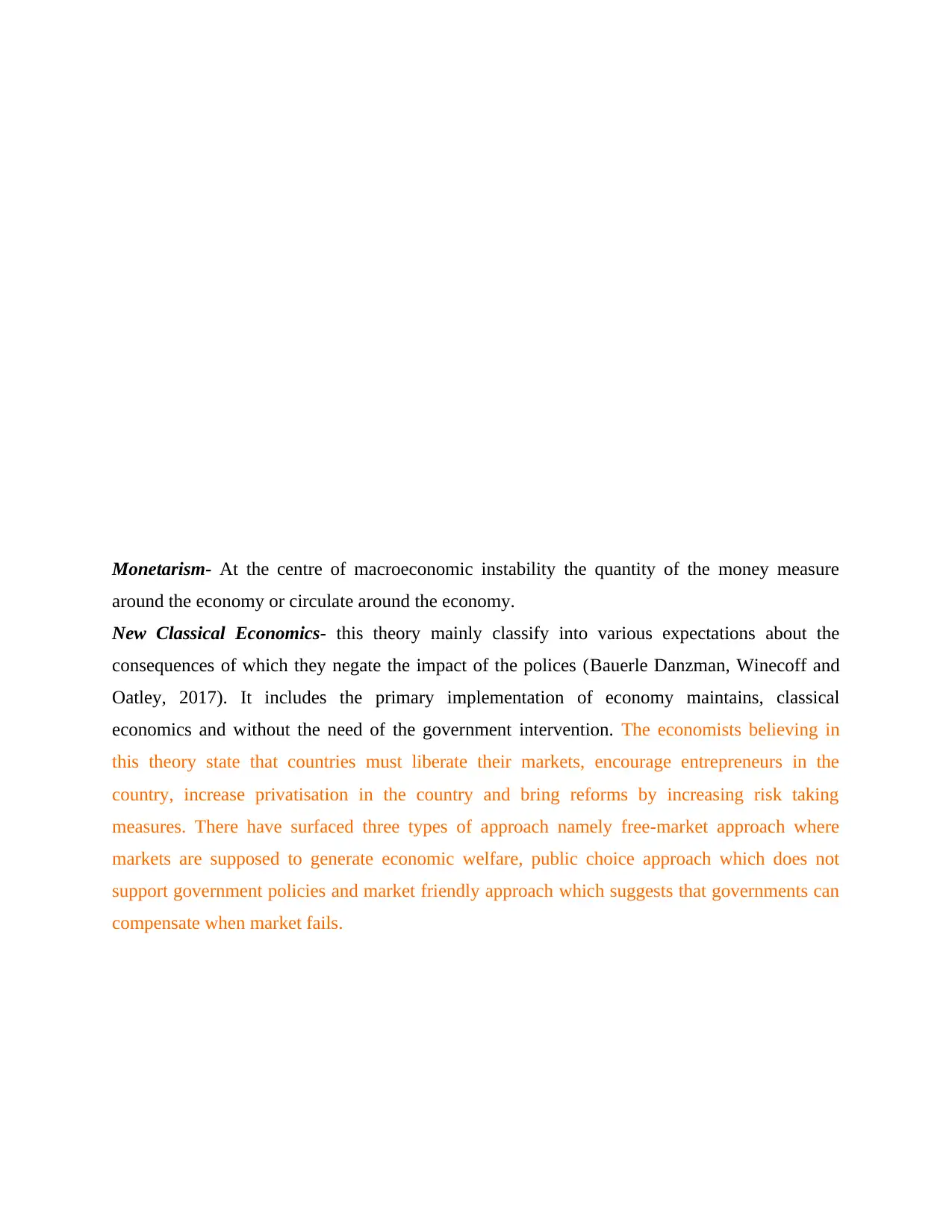
Monetarism- At the centre of macroeconomic instability the quantity of the money measure
around the economy or circulate around the economy.
New Classical Economics- this theory mainly classify into various expectations about the
consequences of which they negate the impact of the polices (Bauerle Danzman, Winecoff and
Oatley, 2017). It includes the primary implementation of economy maintains, classical
economics and without the need of the government intervention. The economists believing in
this theory state that countries must liberate their markets, encourage entrepreneurs in the
country, increase privatisation in the country and bring reforms by increasing risk taking
measures. There have surfaced three types of approach namely free-market approach where
markets are supposed to generate economic welfare, public choice approach which does not
support government policies and market friendly approach which suggests that governments can
compensate when market fails.
around the economy or circulate around the economy.
New Classical Economics- this theory mainly classify into various expectations about the
consequences of which they negate the impact of the polices (Bauerle Danzman, Winecoff and
Oatley, 2017). It includes the primary implementation of economy maintains, classical
economics and without the need of the government intervention. The economists believing in
this theory state that countries must liberate their markets, encourage entrepreneurs in the
country, increase privatisation in the country and bring reforms by increasing risk taking
measures. There have surfaced three types of approach namely free-market approach where
markets are supposed to generate economic welfare, public choice approach which does not
support government policies and market friendly approach which suggests that governments can
compensate when market fails.
Paraphrase This Document
Need a fresh take? Get an instant paraphrase of this document with our AI Paraphraser
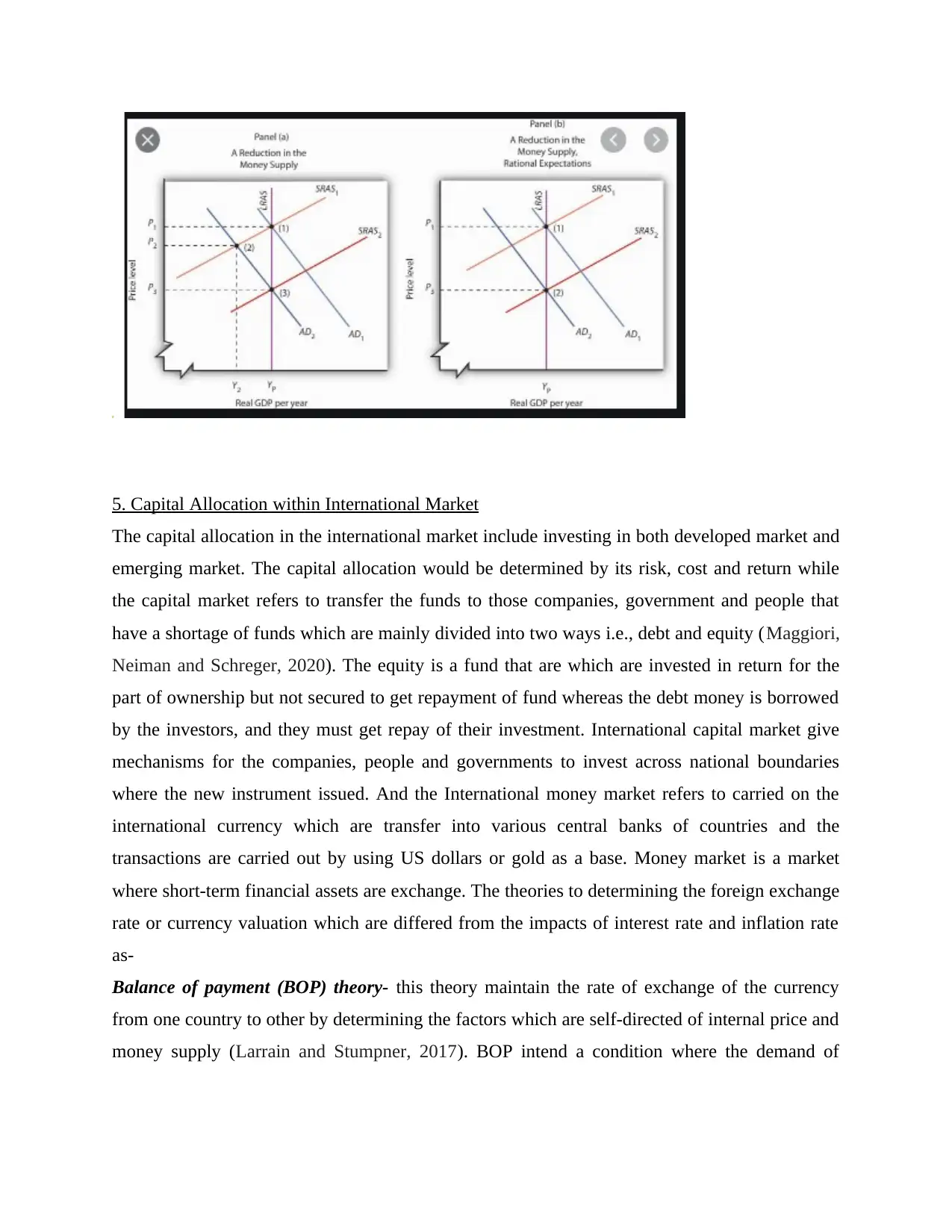
5. Capital Allocation within International Market
The capital allocation in the international market include investing in both developed market and
emerging market. The capital allocation would be determined by its risk, cost and return while
the capital market refers to transfer the funds to those companies, government and people that
have a shortage of funds which are mainly divided into two ways i.e., debt and equity (Maggiori,
Neiman and Schreger, 2020). The equity is a fund that are which are invested in return for the
part of ownership but not secured to get repayment of fund whereas the debt money is borrowed
by the investors, and they must get repay of their investment. International capital market give
mechanisms for the companies, people and governments to invest across national boundaries
where the new instrument issued. And the International money market refers to carried on the
international currency which are transfer into various central banks of countries and the
transactions are carried out by using US dollars or gold as a base. Money market is a market
where short-term financial assets are exchange. The theories to determining the foreign exchange
rate or currency valuation which are differed from the impacts of interest rate and inflation rate
as-
Balance of payment (BOP) theory- this theory maintain the rate of exchange of the currency
from one country to other by determining the factors which are self-directed of internal price and
money supply (Larrain and Stumpner, 2017). BOP intend a condition where the demand of
The capital allocation in the international market include investing in both developed market and
emerging market. The capital allocation would be determined by its risk, cost and return while
the capital market refers to transfer the funds to those companies, government and people that
have a shortage of funds which are mainly divided into two ways i.e., debt and equity (Maggiori,
Neiman and Schreger, 2020). The equity is a fund that are which are invested in return for the
part of ownership but not secured to get repayment of fund whereas the debt money is borrowed
by the investors, and they must get repay of their investment. International capital market give
mechanisms for the companies, people and governments to invest across national boundaries
where the new instrument issued. And the International money market refers to carried on the
international currency which are transfer into various central banks of countries and the
transactions are carried out by using US dollars or gold as a base. Money market is a market
where short-term financial assets are exchange. The theories to determining the foreign exchange
rate or currency valuation which are differed from the impacts of interest rate and inflation rate
as-
Balance of payment (BOP) theory- this theory maintain the rate of exchange of the currency
from one country to other by determining the factors which are self-directed of internal price and
money supply (Larrain and Stumpner, 2017). BOP intend a condition where the demand of
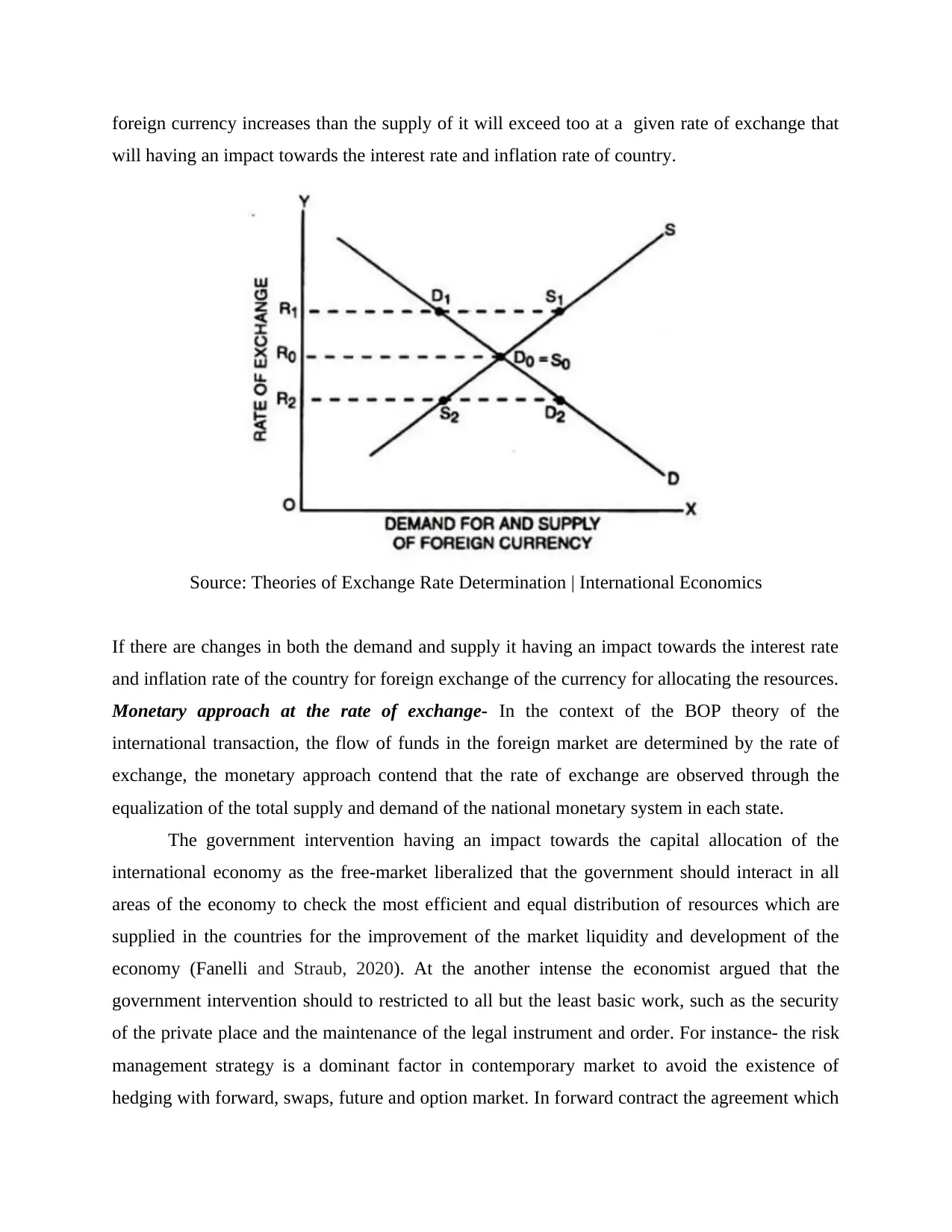
foreign currency increases than the supply of it will exceed too at a given rate of exchange that
will having an impact towards the interest rate and inflation rate of country.
Source: Theories of Exchange Rate Determination | International Economics
If there are changes in both the demand and supply it having an impact towards the interest rate
and inflation rate of the country for foreign exchange of the currency for allocating the resources.
Monetary approach at the rate of exchange- In the context of the BOP theory of the
international transaction, the flow of funds in the foreign market are determined by the rate of
exchange, the monetary approach contend that the rate of exchange are observed through the
equalization of the total supply and demand of the national monetary system in each state.
The government intervention having an impact towards the capital allocation of the
international economy as the free-market liberalized that the government should interact in all
areas of the economy to check the most efficient and equal distribution of resources which are
supplied in the countries for the improvement of the market liquidity and development of the
economy (Fanelli and Straub, 2020). At the another intense the economist argued that the
government intervention should to restricted to all but the least basic work, such as the security
of the private place and the maintenance of the legal instrument and order. For instance- the risk
management strategy is a dominant factor in contemporary market to avoid the existence of
hedging with forward, swaps, future and option market. In forward contract the agreement which
will having an impact towards the interest rate and inflation rate of country.
Source: Theories of Exchange Rate Determination | International Economics
If there are changes in both the demand and supply it having an impact towards the interest rate
and inflation rate of the country for foreign exchange of the currency for allocating the resources.
Monetary approach at the rate of exchange- In the context of the BOP theory of the
international transaction, the flow of funds in the foreign market are determined by the rate of
exchange, the monetary approach contend that the rate of exchange are observed through the
equalization of the total supply and demand of the national monetary system in each state.
The government intervention having an impact towards the capital allocation of the
international economy as the free-market liberalized that the government should interact in all
areas of the economy to check the most efficient and equal distribution of resources which are
supplied in the countries for the improvement of the market liquidity and development of the
economy (Fanelli and Straub, 2020). At the another intense the economist argued that the
government intervention should to restricted to all but the least basic work, such as the security
of the private place and the maintenance of the legal instrument and order. For instance- the risk
management strategy is a dominant factor in contemporary market to avoid the existence of
hedging with forward, swaps, future and option market. In forward contract the agreement which
⊘ This is a preview!⊘
Do you want full access?
Subscribe today to unlock all pages.

Trusted by 1+ million students worldwide
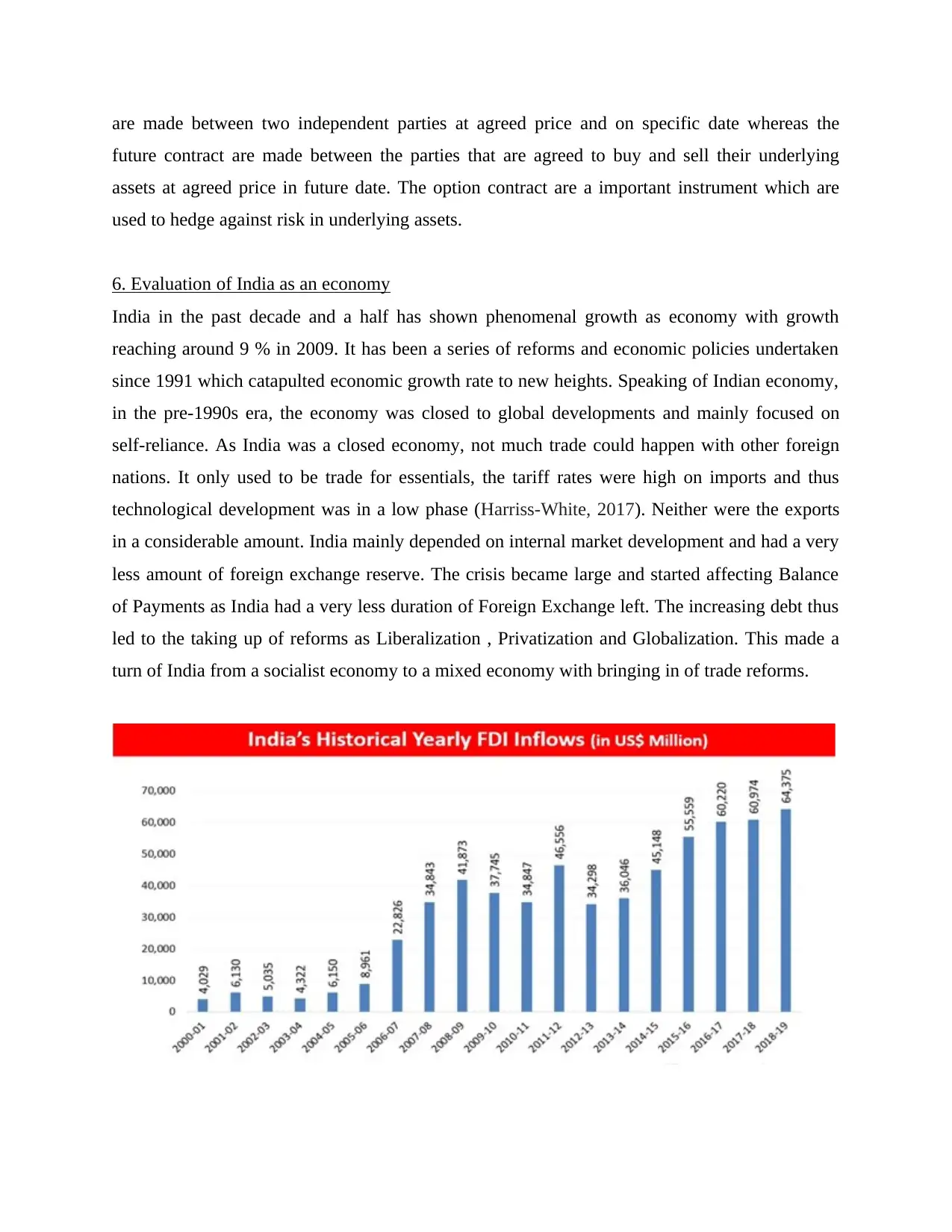
are made between two independent parties at agreed price and on specific date whereas the
future contract are made between the parties that are agreed to buy and sell their underlying
assets at agreed price in future date. The option contract are a important instrument which are
used to hedge against risk in underlying assets.
6. Evaluation of India as an economy
India in the past decade and a half has shown phenomenal growth as economy with growth
reaching around 9 % in 2009. It has been a series of reforms and economic policies undertaken
since 1991 which catapulted economic growth rate to new heights. Speaking of Indian economy,
in the pre-1990s era, the economy was closed to global developments and mainly focused on
self-reliance. As India was a closed economy, not much trade could happen with other foreign
nations. It only used to be trade for essentials, the tariff rates were high on imports and thus
technological development was in a low phase (Harriss-White, 2017). Neither were the exports
in a considerable amount. India mainly depended on internal market development and had a very
less amount of foreign exchange reserve. The crisis became large and started affecting Balance
of Payments as India had a very less duration of Foreign Exchange left. The increasing debt thus
led to the taking up of reforms as Liberalization , Privatization and Globalization. This made a
turn of India from a socialist economy to a mixed economy with bringing in of trade reforms.
future contract are made between the parties that are agreed to buy and sell their underlying
assets at agreed price in future date. The option contract are a important instrument which are
used to hedge against risk in underlying assets.
6. Evaluation of India as an economy
India in the past decade and a half has shown phenomenal growth as economy with growth
reaching around 9 % in 2009. It has been a series of reforms and economic policies undertaken
since 1991 which catapulted economic growth rate to new heights. Speaking of Indian economy,
in the pre-1990s era, the economy was closed to global developments and mainly focused on
self-reliance. As India was a closed economy, not much trade could happen with other foreign
nations. It only used to be trade for essentials, the tariff rates were high on imports and thus
technological development was in a low phase (Harriss-White, 2017). Neither were the exports
in a considerable amount. India mainly depended on internal market development and had a very
less amount of foreign exchange reserve. The crisis became large and started affecting Balance
of Payments as India had a very less duration of Foreign Exchange left. The increasing debt thus
led to the taking up of reforms as Liberalization , Privatization and Globalization. This made a
turn of India from a socialist economy to a mixed economy with bringing in of trade reforms.
Paraphrase This Document
Need a fresh take? Get an instant paraphrase of this document with our AI Paraphraser
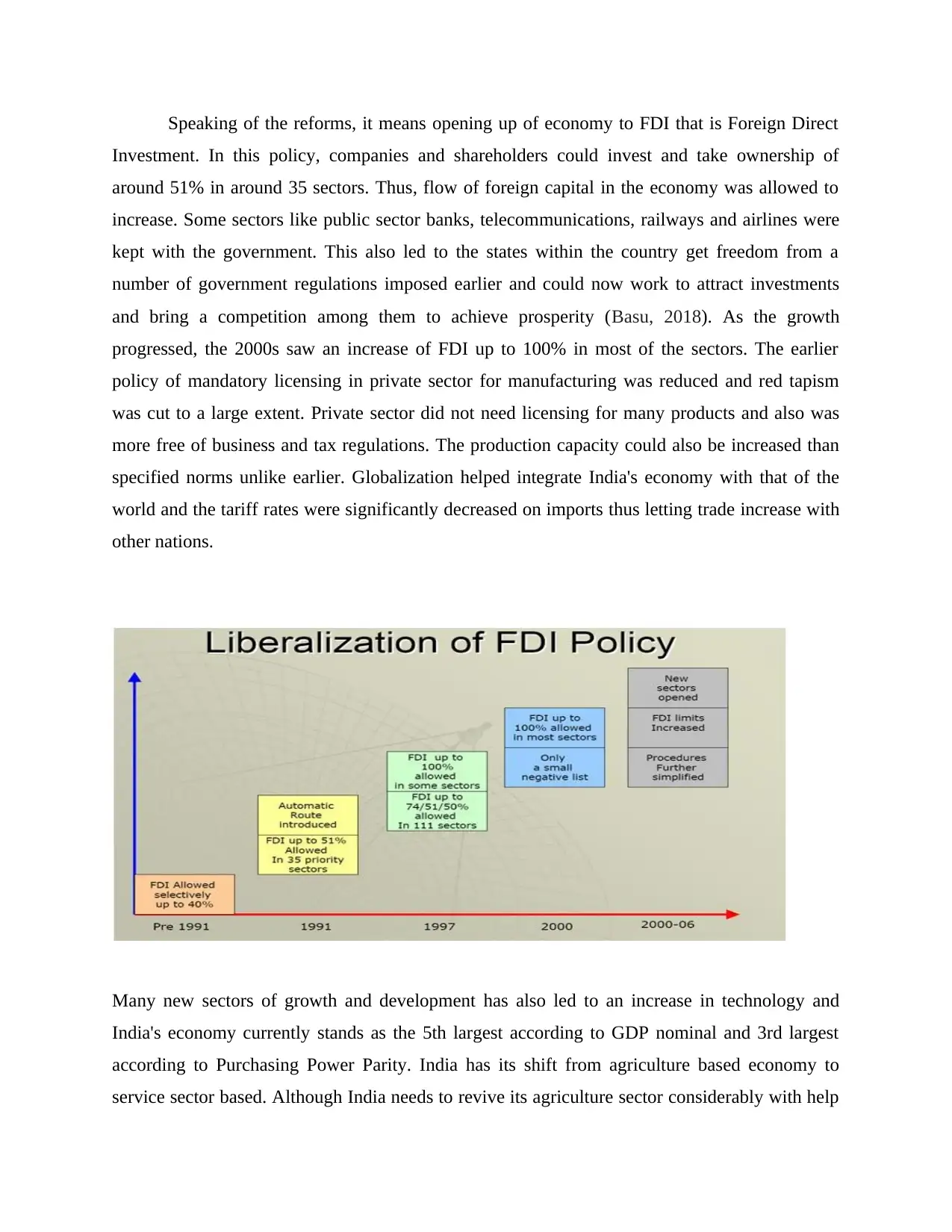
Speaking of the reforms, it means opening up of economy to FDI that is Foreign Direct
Investment. In this policy, companies and shareholders could invest and take ownership of
around 51% in around 35 sectors. Thus, flow of foreign capital in the economy was allowed to
increase. Some sectors like public sector banks, telecommunications, railways and airlines were
kept with the government. This also led to the states within the country get freedom from a
number of government regulations imposed earlier and could now work to attract investments
and bring a competition among them to achieve prosperity (Basu, 2018). As the growth
progressed, the 2000s saw an increase of FDI up to 100% in most of the sectors. The earlier
policy of mandatory licensing in private sector for manufacturing was reduced and red tapism
was cut to a large extent. Private sector did not need licensing for many products and also was
more free of business and tax regulations. The production capacity could also be increased than
specified norms unlike earlier. Globalization helped integrate India's economy with that of the
world and the tariff rates were significantly decreased on imports thus letting trade increase with
other nations.
Many new sectors of growth and development has also led to an increase in technology and
India's economy currently stands as the 5th largest according to GDP nominal and 3rd largest
according to Purchasing Power Parity. India has its shift from agriculture based economy to
service sector based. Although India needs to revive its agriculture sector considerably with help
Investment. In this policy, companies and shareholders could invest and take ownership of
around 51% in around 35 sectors. Thus, flow of foreign capital in the economy was allowed to
increase. Some sectors like public sector banks, telecommunications, railways and airlines were
kept with the government. This also led to the states within the country get freedom from a
number of government regulations imposed earlier and could now work to attract investments
and bring a competition among them to achieve prosperity (Basu, 2018). As the growth
progressed, the 2000s saw an increase of FDI up to 100% in most of the sectors. The earlier
policy of mandatory licensing in private sector for manufacturing was reduced and red tapism
was cut to a large extent. Private sector did not need licensing for many products and also was
more free of business and tax regulations. The production capacity could also be increased than
specified norms unlike earlier. Globalization helped integrate India's economy with that of the
world and the tariff rates were significantly decreased on imports thus letting trade increase with
other nations.
Many new sectors of growth and development has also led to an increase in technology and
India's economy currently stands as the 5th largest according to GDP nominal and 3rd largest
according to Purchasing Power Parity. India has its shift from agriculture based economy to
service sector based. Although India needs to revive its agriculture sector considerably with help
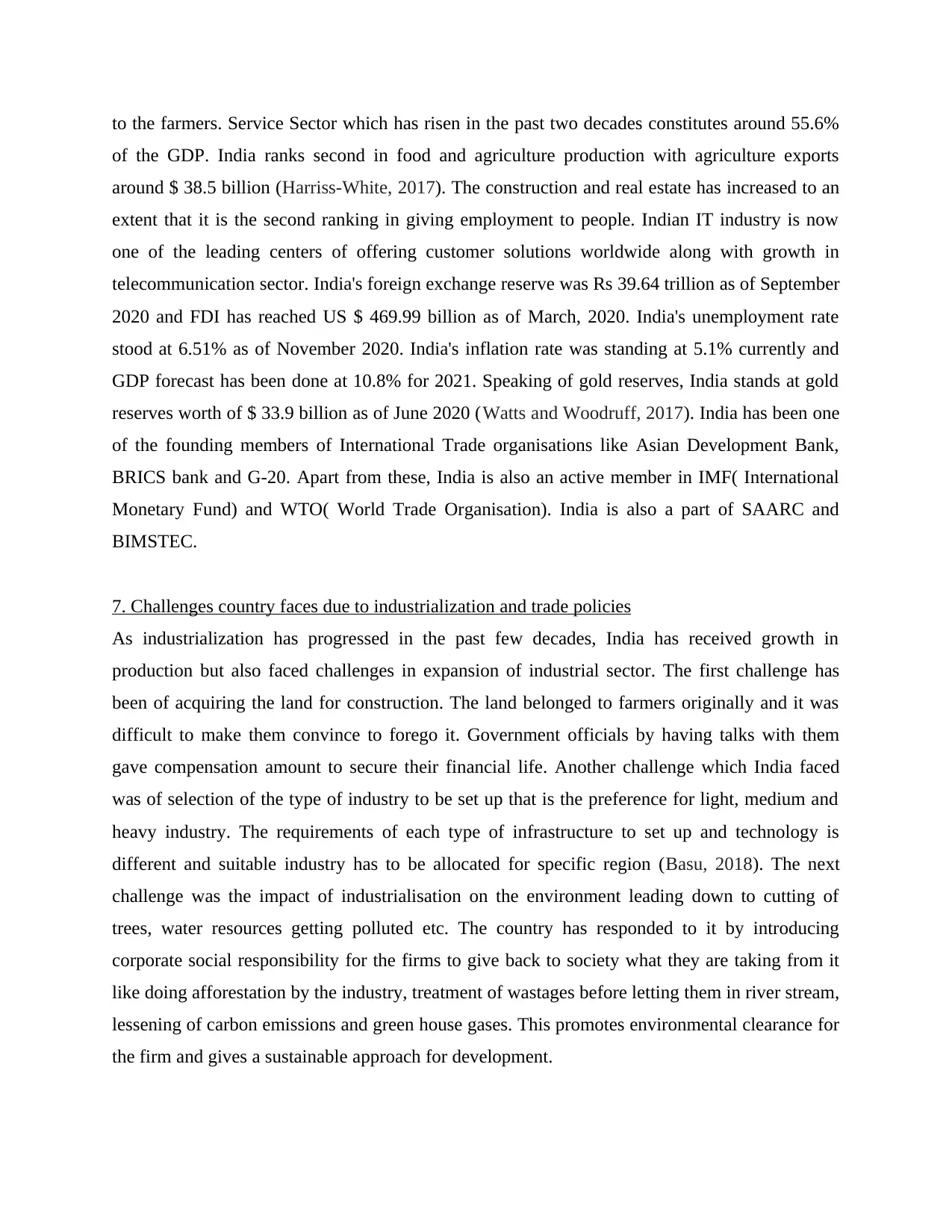
to the farmers. Service Sector which has risen in the past two decades constitutes around 55.6%
of the GDP. India ranks second in food and agriculture production with agriculture exports
around $ 38.5 billion (Harriss-White, 2017). The construction and real estate has increased to an
extent that it is the second ranking in giving employment to people. Indian IT industry is now
one of the leading centers of offering customer solutions worldwide along with growth in
telecommunication sector. India's foreign exchange reserve was Rs 39.64 trillion as of September
2020 and FDI has reached US $ 469.99 billion as of March, 2020. India's unemployment rate
stood at 6.51% as of November 2020. India's inflation rate was standing at 5.1% currently and
GDP forecast has been done at 10.8% for 2021. Speaking of gold reserves, India stands at gold
reserves worth of $ 33.9 billion as of June 2020 (Watts and Woodruff, 2017). India has been one
of the founding members of International Trade organisations like Asian Development Bank,
BRICS bank and G-20. Apart from these, India is also an active member in IMF( International
Monetary Fund) and WTO( World Trade Organisation). India is also a part of SAARC and
BIMSTEC.
7. Challenges country faces due to industrialization and trade policies
As industrialization has progressed in the past few decades, India has received growth in
production but also faced challenges in expansion of industrial sector. The first challenge has
been of acquiring the land for construction. The land belonged to farmers originally and it was
difficult to make them convince to forego it. Government officials by having talks with them
gave compensation amount to secure their financial life. Another challenge which India faced
was of selection of the type of industry to be set up that is the preference for light, medium and
heavy industry. The requirements of each type of infrastructure to set up and technology is
different and suitable industry has to be allocated for specific region (Basu, 2018). The next
challenge was the impact of industrialisation on the environment leading down to cutting of
trees, water resources getting polluted etc. The country has responded to it by introducing
corporate social responsibility for the firms to give back to society what they are taking from it
like doing afforestation by the industry, treatment of wastages before letting them in river stream,
lessening of carbon emissions and green house gases. This promotes environmental clearance for
the firm and gives a sustainable approach for development.
of the GDP. India ranks second in food and agriculture production with agriculture exports
around $ 38.5 billion (Harriss-White, 2017). The construction and real estate has increased to an
extent that it is the second ranking in giving employment to people. Indian IT industry is now
one of the leading centers of offering customer solutions worldwide along with growth in
telecommunication sector. India's foreign exchange reserve was Rs 39.64 trillion as of September
2020 and FDI has reached US $ 469.99 billion as of March, 2020. India's unemployment rate
stood at 6.51% as of November 2020. India's inflation rate was standing at 5.1% currently and
GDP forecast has been done at 10.8% for 2021. Speaking of gold reserves, India stands at gold
reserves worth of $ 33.9 billion as of June 2020 (Watts and Woodruff, 2017). India has been one
of the founding members of International Trade organisations like Asian Development Bank,
BRICS bank and G-20. Apart from these, India is also an active member in IMF( International
Monetary Fund) and WTO( World Trade Organisation). India is also a part of SAARC and
BIMSTEC.
7. Challenges country faces due to industrialization and trade policies
As industrialization has progressed in the past few decades, India has received growth in
production but also faced challenges in expansion of industrial sector. The first challenge has
been of acquiring the land for construction. The land belonged to farmers originally and it was
difficult to make them convince to forego it. Government officials by having talks with them
gave compensation amount to secure their financial life. Another challenge which India faced
was of selection of the type of industry to be set up that is the preference for light, medium and
heavy industry. The requirements of each type of infrastructure to set up and technology is
different and suitable industry has to be allocated for specific region (Basu, 2018). The next
challenge was the impact of industrialisation on the environment leading down to cutting of
trees, water resources getting polluted etc. The country has responded to it by introducing
corporate social responsibility for the firms to give back to society what they are taking from it
like doing afforestation by the industry, treatment of wastages before letting them in river stream,
lessening of carbon emissions and green house gases. This promotes environmental clearance for
the firm and gives a sustainable approach for development.
⊘ This is a preview!⊘
Do you want full access?
Subscribe today to unlock all pages.

Trusted by 1+ million students worldwide
1 out of 16
Related Documents
Your All-in-One AI-Powered Toolkit for Academic Success.
+13062052269
info@desklib.com
Available 24*7 on WhatsApp / Email
![[object Object]](/_next/static/media/star-bottom.7253800d.svg)
Unlock your academic potential
Copyright © 2020–2025 A2Z Services. All Rights Reserved. Developed and managed by ZUCOL.




